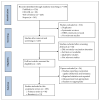How Well the Constructs of Health Belief Model Predict Vaccination Intention: A Systematic Review on COVID-19 Primary Series and Booster Vaccines
- PMID: 37112728
- PMCID: PMC10141697
- DOI: 10.3390/vaccines11040816
How Well the Constructs of Health Belief Model Predict Vaccination Intention: A Systematic Review on COVID-19 Primary Series and Booster Vaccines
Abstract
This systematic review synthesizes the findings of quantitative studies examining the relationships between Health Belief Model (HBM) constructs and COVID-19 vaccination intention. We searched PubMed, Medline, CINAHL, Web of Science, and Scopus using the Preferred Reporting Items for Systematic Reviews and Meta-Analyses (PRISMA) guidelines and identified 109 eligible studies. The overall vaccination intention rate was 68.19%. Perceived benefits, perceived barriers, and cues to action were the three most frequently demonstrated predictors of vaccination intention for both primary series and booster vaccines. For booster doses, the influence of susceptibility slightly increased, but the impact of severity, self-efficacy, and cues to action on vaccination intention declined. The impact of susceptibility increased, but severity's effect declined sharply from 2020 to 2022. The influence of barriers slightly declined from 2020 to 2021, but it skyrocketed in 2022. Conversely, the role of self-efficacy dipped in 2022. Susceptibility, severity, and barriers were dominant predictors in Saudi Arabia, but self-efficacy and cues to action had weaker effects in the USA. Susceptibility and severity had a lower impact on students, especially in North America, and barriers had a lower impact on health care workers. However, cues to action and self-efficacy had a dominant influence among parents. The most prevalent modifying variables were age, gender, education, income, and occupation. The results show that HBM is useful in predicting vaccine intention.
Keywords: COVID-19; HBM; boosters; health belief model; primary series vaccines; systematic review; vaccination intention.
Conflict of interest statement
The authors declare no conflict of interest.
Figures









Similar articles
-
The determinants of COVID-19 vaccination intention: a meta-review.Front Public Health. 2023 Jun 12;11:1162861. doi: 10.3389/fpubh.2023.1162861. eCollection 2023. Front Public Health. 2023. PMID: 37377544 Free PMC article.
-
The Health Belief Model Applied to COVID-19 Vaccine Hesitancy: A Systematic Review.Vaccines (Basel). 2022 Jun 18;10(6):973. doi: 10.3390/vaccines10060973. Vaccines (Basel). 2022. PMID: 35746581 Free PMC article.
-
Predictors of the Third (Booster) Dose of COVID-19 Vaccine Intention among the Healthcare Workers in Saudi Arabia: An Online Cross-Sectional Survey.Vaccines (Basel). 2022 Jun 21;10(7):987. doi: 10.3390/vaccines10070987. Vaccines (Basel). 2022. PMID: 35891150 Free PMC article.
-
COVID-19 Booster Vaccine Hesitancy among Hemodialysis Patients in Saudi Arabia Using the Health Belief Model: A Multi-Centre Experience.Vaccines (Basel). 2022 Dec 31;11(1):95. doi: 10.3390/vaccines11010095. Vaccines (Basel). 2022. PMID: 36679940 Free PMC article.
-
Intention to receive COVID-19 vaccine and its health belief model (HBM)-based predictors: A systematic review and meta-analysis.Hum Vaccin Immunother. 2023 Dec 31;19(1):2207442. doi: 10.1080/21645515.2023.2207442. Epub 2023 May 12. Hum Vaccin Immunother. 2023. PMID: 37170620 Free PMC article.
Cited by
-
The determinants of COVID-19 vaccination intention: a meta-review.Front Public Health. 2023 Jun 12;11:1162861. doi: 10.3389/fpubh.2023.1162861. eCollection 2023. Front Public Health. 2023. PMID: 37377544 Free PMC article.
-
Strategic Combination of Theory, Plain Language, and Trusted Messengers Contribute to COVID-19 Vaccine Uptake: Lessons Learned from Development and Dissemination of a Community Toolkit.Vaccines (Basel). 2023 Jun 5;11(6):1064. doi: 10.3390/vaccines11061064. Vaccines (Basel). 2023. PMID: 37376453 Free PMC article.
-
The paradox of convenience: how information overload in mHealth apps leads to medical service overuse.Front Public Health. 2024 Nov 28;12:1408998. doi: 10.3389/fpubh.2024.1408998. eCollection 2024. Front Public Health. 2024. PMID: 39668954 Free PMC article.
-
Evidence brief on facilitators, barriers and hesitancy of COVID-19 booster doses in Canada.Can Commun Dis Rep. 2024 Oct 3;50(10):338-344. doi: 10.14745/ccdr.v50i10a02. eCollection 2024 Oct. Can Commun Dis Rep. 2024. PMID: 39380803 Free PMC article.
-
Predicting COVID-19 vaccine uptake: Comparing the health belief model and theory of planned behavior.Hum Vaccin Immunother. 2024 Dec 31;20(1):2361503. doi: 10.1080/21645515.2024.2361503. Epub 2024 Jul 15. Hum Vaccin Immunother. 2024. PMID: 39007826 Free PMC article.
References
-
- World Health Organization WHO Coronavirus Disease (COVID-19) Dashboard. [(accessed on 12 March 2023)]; Available online: https://covid19.who.int.
-
- Galanis P., Vraka I., Fragkou D., Bilali A., Kaitelidou D. Intention of healthcare workers to accept COVID-19 vaccination and related factors: A systematic review and meta-analysis. Asian Pac. J. Trop. Med. 2021;14:543. doi: 10.4103/1995-7645.332808. - DOI
Publication types
LinkOut - more resources
Full Text Sources

